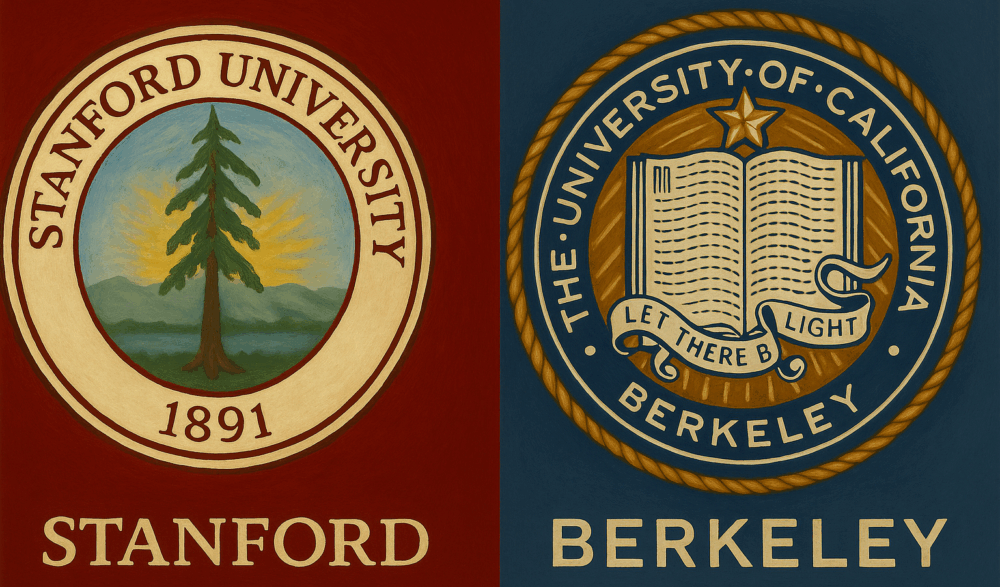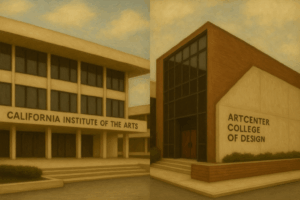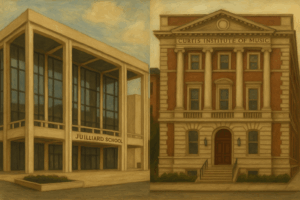
The GOAT of West Coast Universities?
In the American West, the heartland of innovation, sit two colossal intellectual powerhouses that shape the global landscape of technology and thought. One is Stanford University, the symbol of private education that created the Silicon Valley legend on its sun-drenched Palo Alto campus. The other is the University of California, Berkeley, the pride of public universities, which has written a history of free thought and social change across the San Francisco Bay.
The rivalry between these two universities transcends mere academic rankings; it symbolizes the fundamental conflict and harmony between two core values that America presents to the world: ‘entrepreneurial innovation’ driven by private ambition, and ‘social progress’ based on a public mission.
This post moves beyond a superficial comparison of rankings to analyze the deep ‘institutional DNA’ of both universities, based on the latest 2025 data. The journey to find out where your future lies begins now.
Stanford vs. UC Berkeley at a Glance: 2025 Key Metrics Comparison
Before a deep dive into the cultures of the two universities, comparing key quantitative metrics as of 2025 is essential to understanding the fundamental structural differences between the two institutions.
| Metric (2024-2025) | Stanford University | University of California, Berkeley |
|---|---|---|
| 2025 Overall Ranking (US News) | 4th | 17th |
| 2025 Overall Ranking (QS) | 6th | 12th |
| 2025 Engineering Ranking (US News) | 2nd | 3rd |
| Class of 2029 Acceptance Rate | ~3.9% | ~11.0% |
| Total Students (2024-2025) | ~18,625 (7,904 Undergrad) | ~44,000 (~33,000 Undergrad) |
| Undergrad Student-to-Faculty Ratio | 6:1 | 18:1 |
| 2025-2026 Annual Cost of Attendance | ~$96,513 (incl. room & board) | In-state: ~$40,000 / Out-of-state: ~$74,000 (incl. room & board) |
| University Endowment (2024) | $37.6 Billion | $7.9 Billion |
This table clearly illustrates the characteristics of Stanford’s elite private education model (low student numbers, high endowment, low student-to-faculty ratio) versus Berkeley’s large-scale public model (affordable in-state tuition, broad educational opportunities).
Founding Ideals and History: Two Paths to Innovation
To understand the present of these two universities, it is essential to examine their founding backgrounds.
Stanford University: A Pioneering Spirit that Forged Silicon Valley’s Heart from a Wasteland
Stanford’s history begins in 1885 with a tragedy: the death of the only son of railroad magnate Leland Stanford and his wife, Jane Stanford. To honor their son, the couple established an innovative university that broke with the customs of the time, under the vision that “the children of California shall be our children.”
Frederick Terman, the ‘Father of Silicon Valley,’ and the Stanford Research Park
The person who transformed Stanford’s founding ideal of ‘usefulness’ into a real-world miracle was Frederick Terman, Dean of the School of Engineering. He encouraged talented graduates to start their own companies and, in 1951, established the Stanford Research Park, leasing university land to high-tech companies. This was an innovative attempt to blur the lines between academia and commerce and was the decisive moment that made Stanford the heart of an innovation ecosystem.
UC Berkeley: The Public Spirit of California and a Symbol of Freedom
Berkeley’s roots lie in the Morrill Land-Grant Act, signed by President Lincoln in 1862. From the beginning, Berkeley’s mission was not for private gain, but for public service to all the people of California.
The Free Speech Movement (FSM)
In 1964, Berkeley’s public identity was etched into the global consciousness. This movement, which began with student protests against the university administration’s ban on political activities, redefined the university not merely as an ivory tower for transmitting knowledge, but as a key battleground for civil rights and constitutional freedoms. This legacy continues to this day, with Berkeley still serving as a focal point for student activism on social issues.
Campus Culture and Student Life: A Contrast of Two Worlds
Stanford: Intensity Amidst Leisure, The Two Faces of ‘Duck Syndrome’
One of the core elements of Stanford’s culture is the culture of innovation, represented by the d.school (Hasso Plattner Institute of Design). It encourages learning the ‘process’ of innovation through experimentation and challenges without fear of failure.
However, this abundance of opportunity also creates immense pressure.
- Duck Syndrome: This metaphor describes the state where students appear calm and serene on the surface, like a duck gliding on a lake, but are paddling desperately beneath the water to stay afloat. It is a cultural product of Stanford’s hyper-competitive environment, stemming from the cultural pressure to be the best in everything—academics, startups, internships, and more.
UC Berkeley: Diversity and Dynamism, The Power to Change the World
The most prominent feature of Berkeley’s campus culture is activism. The legacy of the Free Speech Movement is alive and well today, and the campus culture not only permits but encourages political and social engagement.
Furthermore, its massive size of about 44,000 students serves as a melting pot, offering students an incredible diversity of people, ideas, and opportunities. Of course, within this environment, students must be much more independent and proactive in finding resources and forming communities, learning strong resilience and self-reliance in the process.
An In-Depth Comparison of Alumni Who Move the World
Both universities have produced numerous individuals who have had a profound impact on the world in their own distinct ways.
Titans of Technology
Stanford: The Architects Who Created New Ecosystems
- Larry Page & Sergey Brin: Developed the ‘PageRank’ algorithm, the foundation of Google, during their Ph.D. studies at Stanford, becoming symbolic figures of how academic research can give birth to a global enterprise.
- William Hewlett & David Packard: Opened the curtain on the Silicon Valley legend by founding Hewlett-Packard (HP) in a small Palo Alto garage.
- Jensen Huang: Co-founder and CEO of Nvidia, the company that created the GPUs that are the engine of the AI era.
- Reed Hastings: Co-founder of Netflix, who disruptively innovated the entire media industry.
- Reid Hoffman: Co-founder of LinkedIn, the world’s largest professional social network.
- Marissa Mayer: A key early executive at Google and former CEO of Yahoo!.
UC Berkeley: The Pioneers Who Democratized Technology
- Steve Wozniak: Co-founder of Apple and the engineering genius who ushered in the era of the personal computer (PC).
- Gordon Moore: Co-founder of Intel and proposer of “Moore’s Law,” the golden rule of the semiconductor industry.
- Eric Schmidt: The former CEO who grew Google into a global behemoth.
Business, Law, and Culture
Stanford: Figures Who Blurred the Lines of Law and Sports
- Sandra Day O’Connor: The first female Supreme Court Justice in U.S. history.
- Tiger Woods: A global sports icon of the 21st century who transcended the game of golf.
UC Berkeley: Masters Who Critiqued Society and Their Times
- Earl Warren: The 14th Chief Justice of the United States who led the ‘Warren Court,’ which ruled racial segregation unconstitutional.
- Jennifer Doudna: A Berkeley professor who won the Nobel Prize in Chemistry for developing the CRISPR gene-editing technology.
- Gregory Peck: A legendary actor who portrayed moral courage on screen.
- Joan Didion: A pioneer of ‘New Journalism’ and an author who captured American culture with a sharp eye.
- Jack London: Author of ‘The Call of the Wild,’ who displayed a rugged and intellectual social consciousness.
- Zulfikar Ali Bhutto: Former President and Prime Minister of Pakistan.
Conclusion: Where Does Your Future Lie? – The Ultimate Stanford vs. Berkeley Guide
The choice between Stanford and Berkeley poses a fundamental question about two different modes of being: ‘creation’ and ‘transformation.’
- Stanford: ‘The Incubator’
It is a resource-intensive environment designed to create new technologies, new companies, and new markets, backed by a massive private endowment and a low student-to-faculty ratio. It values individual ambition and practical achievement above all, demanding that its students become the ‘next big thing’ to disruptively innovate the world. - UC Berkeley: ‘The Public Square’
It is built to challenge and critique existing social structures and to serve the public good within a large and diverse public ecosystem. It emphasizes social responsibility and engagement beyond individual achievement, expecting its students to become a ‘voice for a better world.’
When You Should Choose Stanford:
If you are a prospective entrepreneur with a clear idea, want close mentorship with professors in a small-group setting (6:1 ratio), and are drawn to the challenge of creating ‘the next big thing’ by leveraging abundant, campus-centric resources, then Stanford will be your stage.
When You should Choose UC Berkeley:
If you pursue social impact, value diversity of thought, possess the independence to forge your own path in a large and complex system, and want to lead change from the center of public and political discourse, then Berkeley will be your intellectual home.
Ultimately, do you want to build a new ‘machine’ that moves the world, or do you want to write the ‘manual’ for how society should use that machine? Your answer to this question will determine whether you head to ‘The Farm’ or to the heart of ‘Cal.’


